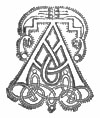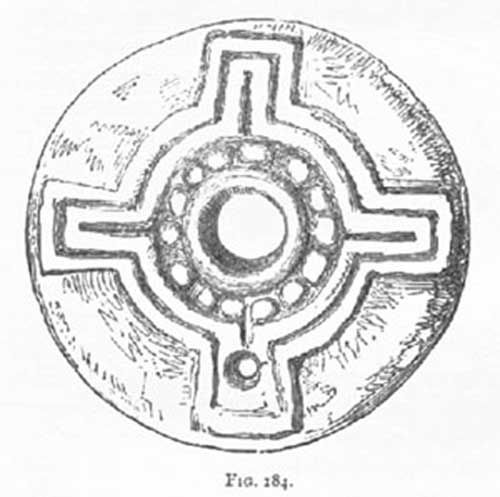Corn Mills and Querns in Ancient Ireland
From A Smaller Social History of Ancient Ireland 1906
« previous page | contents | next page »

Ornament on top of Devenish Round Tower (From Petrie’s Round Towers)
CHAPTER XXI.
CORN MILLS AND QUERNS
SECTION 1. Mills.
 VERY early Irish tradition, transmitted through ancient manuscripts, assigns the erection of the first watermill in Ireland to the illustrious King Cormac mac Art (reigned A.D. 254 to 277). He sent "across the sea" for a mill-wright, who constructed a mill on the stream of Nith, flowing from the well named Nemnach ('sparkling') beside Tara. The spot on which this mill was constructed, and where a mill was kept working time out of mind until very recently, was called Lismullin (the 'fort of the mill'): and the place, which is a mile northeast from Tara, retains the same name to this day.
VERY early Irish tradition, transmitted through ancient manuscripts, assigns the erection of the first watermill in Ireland to the illustrious King Cormac mac Art (reigned A.D. 254 to 277). He sent "across the sea" for a mill-wright, who constructed a mill on the stream of Nith, flowing from the well named Nemnach ('sparkling') beside Tara. The spot on which this mill was constructed, and where a mill was kept working time out of mind until very recently, was called Lismullin (the 'fort of the mill'): and the place, which is a mile northeast from Tara, retains the same name to this day.
Whatever amount of truth may be in this tradition, we have ample evidence that from a period soon after the advent of St. Patrick, watermills were in very general use all through Ireland, and were an important factor in daily life, both in the monasteries and among the people in general. Each muilenn [mullen] or mill was managed by a skilled muilleóir [millore] or miller. Mills and millers are mentioned in the oldest Irish literature; and monastic mills are mixed up with the Lives of many of the early Irish saints.
In the year 651 Donogh and Conall, the two sons of Blathmac (one of the joint kings of Ireland—A.D. 656 to 664), were slain by the Leinstermen at "the mill of Mailoran the son of Dima Crón." This event, which created a great sensation at the time, is recorded in Tighernach, as well as in all the other principal Irish Annals. It happened in this way. On a certain occasion Mailoran and his party pursued the princes, who took refuge among the works of the mill beside the mol or shaft: but the pursuers opened the sluice and let the water run, so that the mill was set going, and the young men were crushed to death in the works. A contemporary poet composed a poem on this event, in which he apostrophises the mill in the following strikingly vivid stanza:—
“O mill, what hast thou ground? Precious thy wheat!
It is not oats thou hast ground, but the offspring of Kervall [i.e. the princes].
The grain which the mill has ground is not oats but blood-red wheat;
With the scions of the great tree (Kervall, their ancestor) Mailoran's mill was fed.”
This mill was situated on the little river that runs from Lough Owel to Lough Iron in Westmeath, near the point where the river is now crossed by a bridge; and the place still retains the name of Mullenoran. It is curious that a mill existed there from the time of the death of the princes—and no one can tell how long before—down to the end of the eighteenth century; and there are some old people still living there whose grandfathers saw it in full work.
A mulenn or mill is mentioned in the St. Gall glosses of Zeuss—seventh or eighth century—at which time the name mulenn, which is used in the Irish passage copied by Zeuss, and which was borrowed from Latin, had become well naturalised in the Irish language. We may then take it for certain that watermills—howsoever derived—were in use in Ireland from the earliest ages of Christianity. Accordingly the statement, which is sometimes made, that mills were introduced into this country by the Danes is quite erroneous, inasmuch as they were known and worked here long before the Danes ever appeared on our shores. But there is as yet no sufficient evidence to prove that they were known in pagan times.
Ancient mill-sites and the remains of old mills have been found in various parts of Ireland buried deep in bog or clay, always beside a stream, many presenting appearances of very remote antiquity. Some are small horizontal-wheel mills, which were common down to recent times; some are the remains of larger mills with vertical overshot wheels. In most of those sites millstones have been found, of various sizes up to three feet in diameter: and there is often a long narrow oaken trough or shoot—generally hollowed out from a single tree-trunk—for conveying the water to the wheel. Parts of the framework surrounding the mill, with the flooring, also remain in some of these old sites, mortised together, but never fastened by nails: the woodwork of all generally of oak.
The mills used in Ireland were of various shapes and sizes, which, as well as the modes of working them and preparing the com for grinding, will be found fully described in my larger work, "A Social History of Ancient Ireland."
FIG. 184. Upper stone of a Quern: 18 inches in diameter: in National Museum. (From Wilde's Catalogue).

